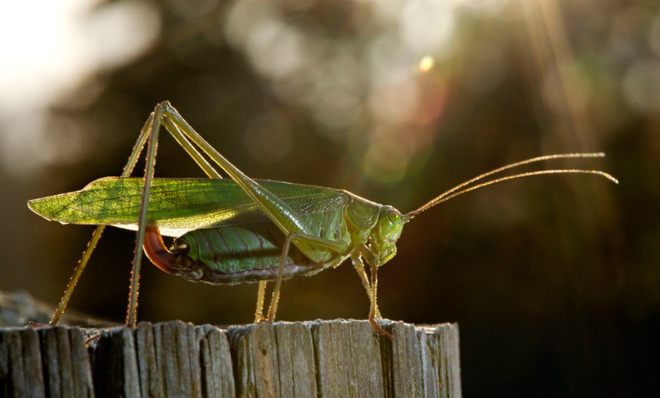Why you want to save the whales, but not the crickets
Not all wildlife is created equal in our eyes, and our perception matters a lot when it comes to conservation

The 2012 elections cost roughly $6 billion. Yes, that's extraordinarily expensive — but hey, we were electing the leader of the free world. So you might be surprised to hear that that $6 billion figure is about the same value that Americans place on monarch butterflies.
Yes, monarchs, those black and orange butterflies that fly through much of the U.S. as they migrate between their northern breeding grounds and their southern winter homes. They're the official insect or butterfly of seven different states, and were once nominated as the national insect. They're celebrated at festivals all over North America and protected in butterfly sanctuaries. They're the stars of a documentary. People love them, to say the least. And when researchers asked thousands of people throughout the country what they would spend or have spent on growing monarch-friendly plants or donations to monarch conservation organizations, they came up with a total one-time payment of $4.78 billion to $6.64 billion.
That's not quite the price tag that people put on animals like whales or wolves, but about the same as the perceived value of some other large vertebrates and way out of the league of most bugs. How do we decide the monetary worth of an entire species?
The Week
Escape your echo chamber. Get the facts behind the news, plus analysis from multiple perspectives.

Sign up for The Week's Free Newsletters
From our morning news briefing to a weekly Good News Newsletter, get the best of The Week delivered directly to your inbox.
From our morning news briefing to a weekly Good News Newsletter, get the best of The Week delivered directly to your inbox.
Not all wildlife is created equal in our eyes, and our perception matters a lot when it comes to conservation. Large, iconic species — think elephants, lions, pandas, and other "charismatic megafauna" — usually reap the lion's share of attention and conservation funding while leaving many other species out in the cold.
Most of these forgotten animals are small, slimy, icky, or ugly — like insects, snakes, amphibians, and fish. They're not as well-studied as birds and mammals, and are less likely to receive protection under the Endangered Species Act. They probably won't ever be the faces of global conservation charities, and you'll never see anyone walking around in a "Save the Glandular Bush Crickets" shirt.
This "taxonomic bias" affects the public, politicians, and even conservation scientists — but what causes it? Why does someone decide that they should put more money or time or effort into helping pandas than, say, purple pig-nosed frogs?
The first hurdle that less-than-glamorous species have to face is aesthetics. Bugs, snakes, sharks ,and some other animals simply aren't cute, and protecting cute things is "hard-wired into our brains," zoologist Nathan Yaussy writes at Earth Times.
A free daily email with the biggest news stories of the day – and the best features from TheWeek.com
"This means that the more baby-like an animals is, the more we want to save it," he says. "Big eyes, round heads, and short snouts are all characteristics that set off the 'cute' response."
That cute response can translate directly to dollars. In an experiment, people were shown different versions of a flyer from a made-up environmental organization calling for protection for either a species of bat or ape. The flyer either had a picture of an attractive example of the animal on it, a picture of an ugly animal, or no picture at all. For both animals, people were willing to give more money to help protect the species if the attractive picture was used. Even the picture-less poster got them to open their wallets more than the ugly bat. Clearly, looks matter, even to charismatic, human-like animals like apes.
That's another factor in the valuation of a species: anthropomorphism. People like animals that are similar to us physically and behaviorally, or have characteristics that have positive connotations, like strength and cunning. When researchers from the UK showed people pictures of 40 different species and asked them to rate their like or dislike of the animals, they found that a "clear relationship between similarity and preference exists, suggesting that humans are predisposed to liking species on the basis of shared bio-behavioral traits." Since people are known to be more empathetic, helpful, and attracted to people they perceive as similar to them, the researchers suggest, we might also extend that bias to non-human animals.
"To act," says psychologist Jackie Abell, "humans must identify with those they seek to protect." The more similar animals are to us and the closer we place them to us in our human-centric worldview, the more likely we are to feel a moral duty to care for them, and a sense of psychological belonging with them. The fact that chimpanzees use tools resonates with us. It helps us see ourselves in them and makes us like them and want to help them more. The fact that some wasps turn cockroaches into zombies, eat part of them, and then live inside the carcasses? Not so much.
There are a variety of other factors that also play smaller roles in how we value animals, like gender, location, and the potential threat that an animal can pose.
In studies, women show more affinity than man do for "lovable animals," and less for ones that are perceived as disgusting or dangerous, which lowers their willingness to protect them. In southern India, women specifically have more negative attitudes than men toward lion-tailed macaques. While these monkeys hit the "cute" and "similar to us" criteria, they also have a habit of sneaking into houses and stealing food. Since women are mostly responsible for maintaining the home in this region, these adorable invaders affect them more and color their feelings about macaques.
The potential for human-wildlife conflict can also impact the value of a normally beloved species depending on where in the world you are. While tigers and elephants are conservation icons in the West, both men and women in the animals' Indian ranges expressed less appreciation and even dislike for them because of instances where the animals destroy crops and injure people.
Some animals also just have bad reputations — as pests, as killers, as bad omens. The greater mouse-eared bat — which is actually kind of cute compared to some other bats — was rated the least-liked species out of a group of mammals in a Swiss study. Why? Bats have an age-old PR problem.
"Like many other nocturnal creatures, bats give rise to primal fears," the researchers wrote. "The vampire myth, which originates from a limited number of blood-sucking species in South America, still haunts certain people and continues to reinforce the poor image of bats."
The same people that gave the bat a thumbs-down also showed a strong aversion to insects because of their association with disease, and the potential to inflict harmful stings or bites — even though, the researchers point out, "many European countries have no deadly poisonous spiders or insects."
An animal doesn't even have to be related to a disliked group to get lumped in with them and saddled, in people's minds, with their negative characteristics. In another study, the elephant shrew was rated negatively because of its resemblance to disease-carrying rats —despite not being a rodent or having any historical association with disease (and also being kind of cute in a weird way).
It's not just psychological biases like these that place charismatic megafauna at the top of the animal heap, though. Certain species are more valued in our collective consciousness because conservation groups told us they should be.
Groups like the World Wildlife Fund often direct their conservation efforts toward, and build public attention around, what conservationists call "flagship species." These are the iconic animals that are not only easy to raise awareness and funds and stimulate action for, but also make good ambassadors for the habitats they live in and the other animals that share it. Attention, effort, and money that helps preserve a flagship species, the thinking goes, also helps the less charismatic critters that live in its shadow, either directly or by improving the habitat or leveraging conservation commitments from governments.
Whether that idea actually works out or not isn't clear. The evidence that this "trickle down conservation" effect happens is mixed. What's more, people can get "flagship fatigue" from too much exposure to these species, which reduces their effectiveness as ambassadors.
In a way, that's good news for all the other animals out there that have gotten the short end of the stick. "The appeal of novelty and interest in less traditionally charismatic species should not be overlooked," write British conservation scientists Evan Bowen-Jones and Abigail Entwistle. When people get tired of the pandas and elephants and other usual suspects, the ugly and odd have a chance to shine and can generate public interest through their novelty and unusual appearances or behavior.
It's worked before. Reptiles low on charisma and cuteness like skinks and snakes have been used to raise awareness of conservation issues in the Caribbean. The Komodo dragon, a venomous lizard that grows up to eight feet long and occasionally attacks people, isn't an obvious pick for a flagship species. And yet, it's become one in its native Indonesia because it attracts tourists and funds to a remote national park and raises local support for conservation projects.
Under the right circumstances, the animals that usually don't get to sit at the conservation cool kids table can get a little love. And despite all our biases against them, there's also one that works for them. Research suggests that when people find out an ugly animal is endangered, they perceive it as being more attractive and more worthy of their support. For the species that may not be cute or charismatic or humanlike, beauty is thankfully sometimes in the eye of the beholder.
-
 5 sleeper hit cartoons about Sleepy Don
5 sleeper hit cartoons about Sleepy DonCartoon Artists take on cabinet meetings, a sleepy agenda, and more
-
 Political cartoons for December 6
Political cartoons for December 6Cartoons Saturday’s political cartoons include a pardon for Hernandez, word of the year, and more
-
 Pakistan: Trump’s ‘favourite field marshal’ takes charge
Pakistan: Trump’s ‘favourite field marshal’ takes chargeIn the Spotlight Asim Munir’s control over all three branches of Pakistan’s military gives him ‘sweeping powers’ – and almost unlimited freedom to use them